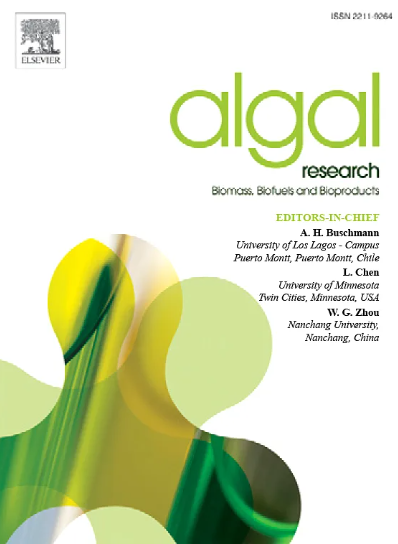利用响应面方法优化营养培养基中的铁、磷酸盐和盐度,提高小球藻培养的生化成分
IF 4.6
2区 生物学
Q1 BIOTECHNOLOGY & APPLIED MICROBIOLOGY
Algal Research-Biomass Biofuels and Bioproducts
Pub Date : 2024-10-14
DOI:10.1016/j.algal.2024.103747
引用次数: 0
摘要
微藻小球藻是一种极具科学和商业吸引力的单细胞微生物,作为人类和动物的营养补充剂,它已发展成为一个稳定的产业。人们使用各种营养培养基来培养小球藻,以提高其生长、色素沉着和脂质含量。然而,小球藻培养物的最佳生化成分和密度需要了解优化营养介质以研究其生产。本研究旨在利用响应面方法学(RSM)研究铁、磷酸盐和盐浓度在营养介质中协同作用对小球藻培养物的生长响应、色素和脂质积累的影响。利用 RSM 软件得出的结果,共评估了 18 个实验组(E1 - E18),并进行了一项确认(C)研究。结果显示,小球藻培养的 E7 实验组的细胞密度和特定生长率(SGR)最高,分别为 176.00 × 106 cells mL-1 和 0.35 day-1。同样,E5 和 E1 实验产生的细胞密度最高,分别为 166.10 × 106 cells mL-1 和 152.13 × 106 cells mL-1。E5 实验和 E1 实验的 SGR 也分别增加了 0.33 天-1 和 0.33 天-1。因此,在营养培养基中培养高浓度铁和磷酸盐以及低盐度的小球藻,其细胞数、SGR 和色素积累(叶绿素 a 和类胡萝卜素总量)都是最高的。此外,高浓度盐度会降低小球藻的生长。然而,小球藻培养物生长的增加并不表明其他生化成分的增加。在某些情况下,生化成分的增加是由于营养限制或压力因素造成的。例如,在色素积累方面,实验 E7 中叶绿素 a 色素积累增加(51.57 μg mL-1),而实验 E8 中类胡萝卜素总积累增加(20.68 μg mL-1)。此外,盐浓度的增加会增加每个细胞的叶绿素 a 和类胡萝卜素总量,但会降低小球藻的生长,如 E4 实验所示,其叶绿素 a 水平为 1.38 pg cell-1,类胡萝卜素总量水平为 0.52 pg cell-1。此外,在 E3 实验中,小球藻培养产生了较高的脂质积累,达到 37.38%。因此,本研究结果有助于了解小球藻培养物的最佳生化组成和细胞生长。本文章由计算机程序翻译,如有差异,请以英文原文为准。
Optimization of iron, phosphate, and salinity in nutrient medium using response surface methodology for enhancing biochemical composition in Chlorella sp. culture
Microalga Chlorella sp. is a highly scientifically and commercially attractive unicellular microorganism and has developed a stable industry as a nutritional supplement for people and animals. Various nutrient media have been used to grow Chlorella sp. cultures to enhance their growth, pigmentation, and lipid content. However, the optimal biochemical composition and density of Chlorella sp. cultures require an understanding of optimizing the nutrient medium to study their production. The present study aims to investigate the effects of iron, phosphate, and salinity concentrations by working synergically in a nutrient medium on the growth responses, pigments, and lipid accumulation of Chlorella sp. culture using a response surface methodology (RSM) approach. Using the result from the RSM software, a total of 18 experimental groups (E1 – E18) were evaluated, and one confirmation (C) study was conducted. The results revealed that the E7 experiment in Chlorella sp. culture provided the highest cell density and specific growth rate (SGR) with 176.00 × 106 cells mL−1 and 0.35 day−1, respectively. Similarly, the E5 and E1 experiments produced the highest cell density of 166.10 × 106 cells. mL−1 and 152.13 × 106 cells mL−1, respectively. The SGR was also increased at 0.33 day−1 in the E5 experiment and 0.33 day−1 in the E1 experiment. Consequently, the culture of Chlorella sp. containing high iron and phosphate concentrations and lower salinity in a nutrient medium had the highest number of cells, SGR, and pigment accumulation (chlorophyll a and total carotenoid). In addition, the presence of high salinity concentrations reduces Chlorella sp. growth. However, the increase in the growth of Chlorella sp. culture did not indicate an increase in other biochemical compositions. In some cases, biochemical compositions are high due to nutritional limitations or stress factors. For example, in pigment accumulation, chlorophyll a pigment accumulation was increased in experiment E7 (51.57 μg mL−1), while total carotenoid accumulation was increased in experiment E8 (20.68 μg mL−1). In addition, increasing salinity concentration increased chlorophyll a and total carotenoid contents per cell, but decreased Chlorella sp. growth as shown in the E4 experiment, which achieved chlorophyll a levels of 1.38 pg cell−1 and total carotenoid levels of 0.52 pg cell−1. Furthermore, Chlorella sp. culture produces a higher lipid accumulation of 37.38 % in the E3 experiment. Hence, the results of this study contribute to understanding the optimal biochemical composition and cell growth of Chlorella sp. cultures.
求助全文
通过发布文献求助,成功后即可免费获取论文全文。
去求助
来源期刊

Algal Research-Biomass Biofuels and Bioproducts
BIOTECHNOLOGY & APPLIED MICROBIOLOGY-
CiteScore
9.40
自引率
7.80%
发文量
332
期刊介绍:
Algal Research is an international phycology journal covering all areas of emerging technologies in algae biology, biomass production, cultivation, harvesting, extraction, bioproducts, biorefinery, engineering, and econometrics. Algae is defined to include cyanobacteria, microalgae, and protists and symbionts of interest in biotechnology. The journal publishes original research and reviews for the following scope: algal biology, including but not exclusive to: phylogeny, biodiversity, molecular traits, metabolic regulation, and genetic engineering, algal cultivation, e.g. phototrophic systems, heterotrophic systems, and mixotrophic systems, algal harvesting and extraction systems, biotechnology to convert algal biomass and components into biofuels and bioproducts, e.g., nutraceuticals, pharmaceuticals, animal feed, plastics, etc. algal products and their economic assessment
 求助内容:
求助内容: 应助结果提醒方式:
应助结果提醒方式:


